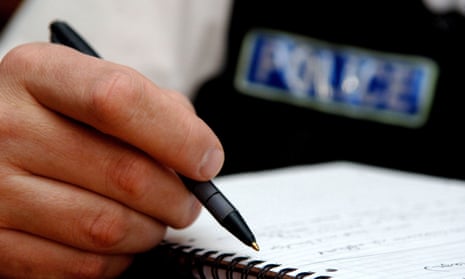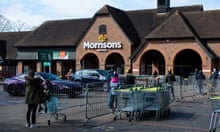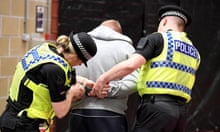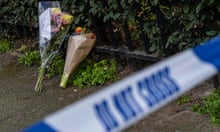The rise in crime is accelerating, with the latest figures showing a 13% increase in all police-recorded offences across England and Wales, and even greater rises for violent offences including knife crime, sexual offences and violence against the person.
The crime figures show an underlying 8% rise in the murder rate, an increase of 46 victims, with 629 homicides recorded in the 12 months to June, excluding the 35 people killed in the London and Manchester terrorist attacks, and the 96 Hillsborough deaths in 1989, which were included in the headline figures.
The acceleration from a 5% rise in the 12 months to June 2015, to 7% the following year, and 13% in the 12 months to June this year, together with even larger increases in violent crime, will sound alarm bells in Downing Street.
Theresa May might find some comfort in the results of the Crime Survey of England and Wales, which shows a 9% reduction in overall crime but is less effective at providing a good indication of changes in low-volume offences, including most forms of violent crime, or emerging trends.
John Flatley of the Office for National Statistics (ONS) said: “Today’s figures suggest that the police are dealing with a growing volume of crime. While improvements made by police forces in recording crime are still a factor in the increase, we judge that there have been genuine increases in crime, particularly in some of the low-incidence but more harmful categories.
“Police figures cannot provide a good measure of all crime in society, since we know that a large volume of it never comes to their attention. The recent increases in recorded crime need to be seen in the context of the overall decline in crime indicated by the Crime Survey of England and Wales.”
The shadow home secretary, Diane Abbott, said: “The Tories can no longer hide behind claims that crime is falling to justify their severe cuts to the police.
“They have left our communities exposed, with police numbers the lowest on record at a time when forces are under unprecedented pressure from surging crime, an ongoing terror threat, and from covering for cuts to other services.”
Sarah Newton, a Home Office minister, welcomed the fall in the crime survey estimates and improvements in police recording.
“But while it is clear that much of the rise in police-recorded violent offences is due to better recording, we know that some of this increase is likely to be genuine, which is why we have taken urgent action to stop these crimes and keep our communities safe,” she said.
“This week, we began consulting on tough new laws to crack down on acid attacks and knife offences. Our domestic abuse bill will help to bring this heinous crime out of the shadows and ensure victims receive both support and justice, as we invest £100m to prevent and confront violence against women and girls. We are also investing £1.9bn to counter the cyber threats we face.”
The ONS said police had recorded 5.2m offences in the year to June, which reflected genuine increases in some crime categories as well as continuing improvements in some categories. The crime survey estimated that there were 10.8m incidents, including 5m of fraud, online crime and computer misuse. In contrast to the police figures, it showed the majority of crime categories falling or showing no statistical difference.
The quarterly crime figures also highlight for the first time 711 deaths or serious injuries caused by illegal driving, a 6% rise on the previous year.
But it is the accelerating increases in the volume of violent crime reported to police that will most alarm the public and politicians.
The ONS said the underlying rise in the homicide rate followed a general upward trend in recent years and contrasted with the downward trend over the previous decade. The headline figure of 664 homicides for the 12 months to June shows a fall of 2% on the previous year’s total of 679.
The increasingly violent nature of England and Wales is underlined by double-digit increases in types of violent crime that, although low in volume, cause significant harm and alarm. They include a 27% rise in gun crime to 6,696 offences, a 26% increase in knife crime to 36,998 offences, robberies up 25% to 64,499, sexual offences up 19% to 129,700, and stalking and harassment up 36% to 243,086 reported incidents.
The overall category of violence against the person, which includes homicide, death or serious injury caused by illegal driving, violence with injury, violence without injury, and stalking and harassment, rose 19% to 1,229,260 reported incidents.
There were also double-digit increases in domestic violence and public order offences. Some categories of police-recorded crime fell in the past year, including drug offences, down 9% to 132,935, and non-domestic burglary.
The largest increases in violent crime were reported by South Yorkshire police, up 49% to 31,838 offences, Durham constabulary (up 48% to 16,532 offences), Greater Manchester police (up 46% to 76,404 offences) and Northumbria police (up 39% to 35,458 offences).
But it will cause increasing political alarm that large-volume offences such as burglary and car crime, which had been falling over the previous two decades, are rising. Domestic burglary is up 21% to 235,335, while thefts are up 11% to 1.9m.
The Home Office data shows there were more than 8,000 allegations of rape reported to police that were not officially recorded as rapes.
There were 52,406 allegations initially classified as rapes in the 12 months to March, of which 41,159 were subsequently officially recorded, leaving 8,624 cases that were not pursued. Of the remaining 2,623, 1,746 were “cancelled” due to additional “verifiable information” that indicated a rape did not take place, the crime had already been recorded or it had been recorded in error, while 877 allegations were transferred to other forces to consider.
A Home Office data table shows the reason for 4,920 of the 8,624 cases not being recorded was: “Victim/third party not confirmed/cannot be traced”. A further 1,320 were not pursued because “credible evidence exists to the contrary”. The remaining 2,384 cases involved incidents committed outside the jurisdiction of the police force they were reported to and transferred to the appropriate force.










